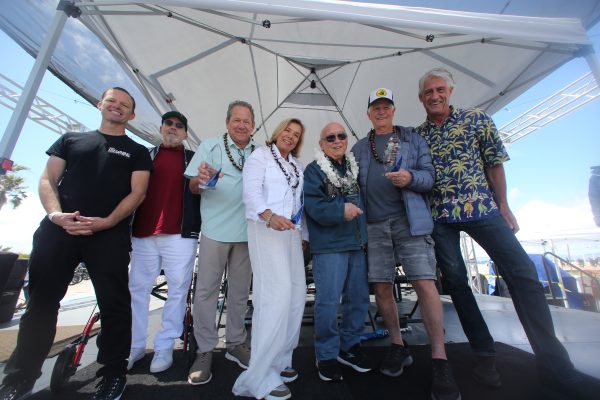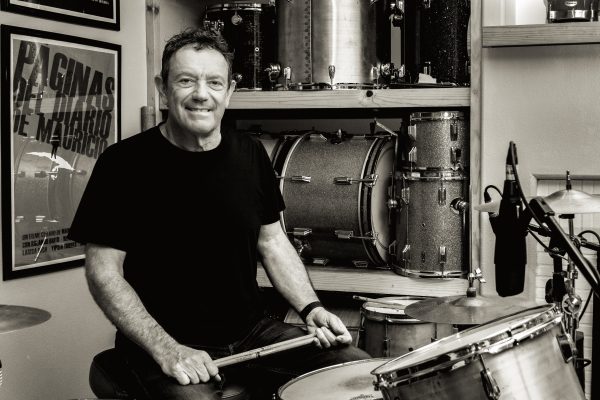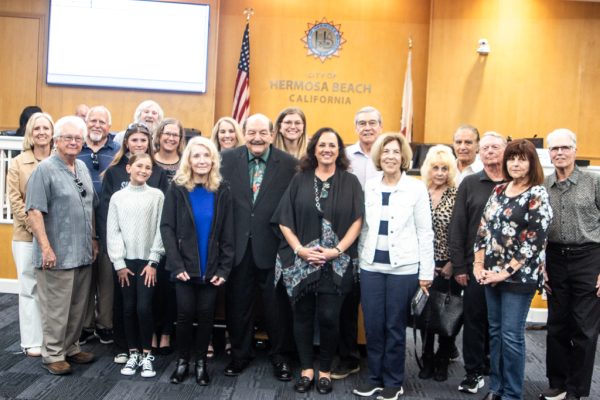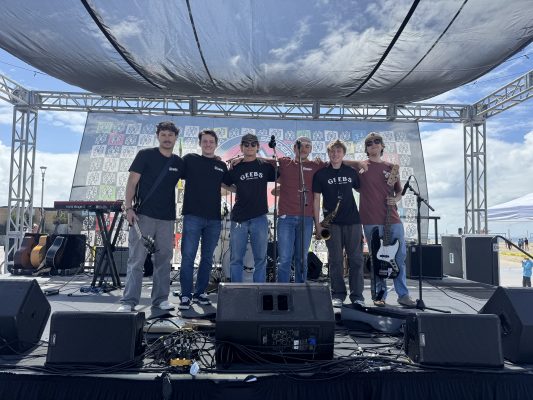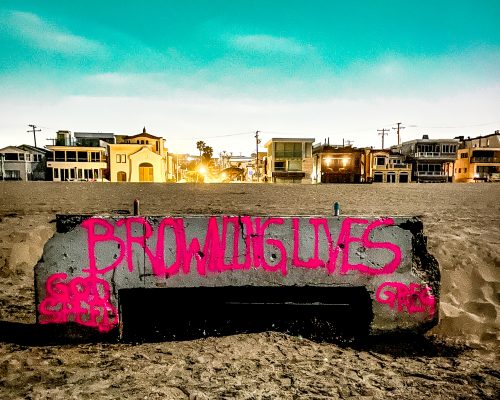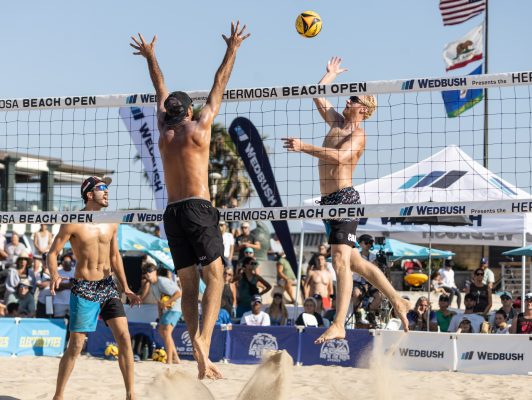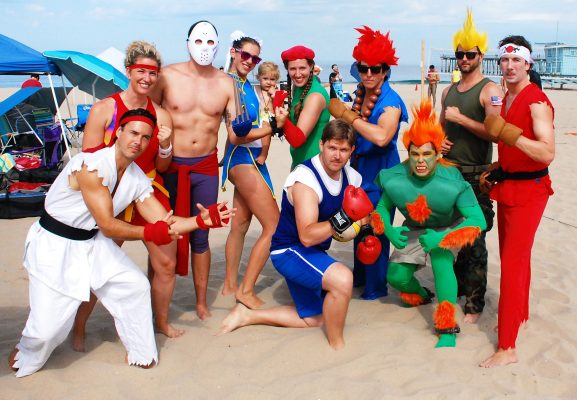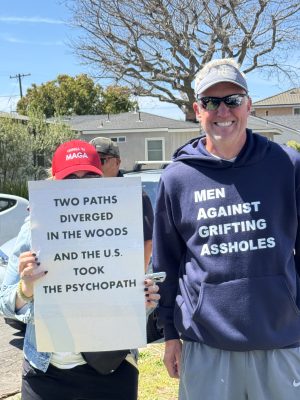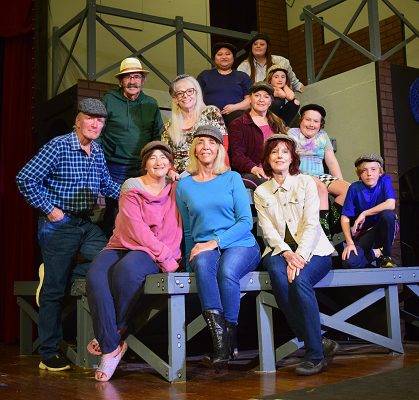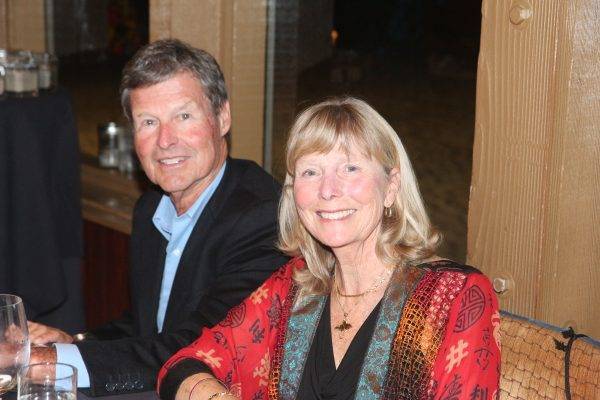How legendary surf artist Phil Roberts entered Augmented Reality
by Mark McDermott
Eli Buck had a dream. It wasn’t a big dream, not a society-shifting MLK kind of dream, nor exactly a life-changing kind of dream. But it wasn’t a little one, either. His dream was to make a really cool beer can.
Buck is the art director for the El Segundo Brewing Company. Earlier this summer, as the El Segundo Art Walk approached, the brewery decided to make a brew specifically for the event. ESBC and ESAW have had nearly a decade-long love affair, and the brewery wanted to do something special for the Art Walk.
ESAW first sprang to life in 2015 and from the beginning was a different kind of art walk. ESAW sprawled from the upper end of Grand Avenue, all through the Mayberry-esque downtown, all the way out to far reaches of the Smoky Hollow warehouse district. To say it included over 40 businesses doesn’t capture the Wild West carnival-like excitement of the event, which included everything from motorcycle and surf shops to a factory that made furniture out of airplane parts, an avant garde art museum, glassblowers and rope dancers. The ESBC brewery on Main Street served as an unofficial hub.
ESBC had never created a beer specifically for the Art Walk before, but they had made some cool cans inspired by ESAW, including cans designed by legendary “Endless Summer” artist John Van Hamersveld, surrealist urban surf artist Damian Fulton, and “pop surrealist” surf artist Rick Rietveld.
Now, El Segundo Brewing was going to make a beer specifically for ESAW. Buck’s dream was to make that ESAW beer can sing. He wanted another bigtime artist.
His first instinct was to reach out to Fulton and Rietveld. Both were booked. But Rietveld had a suggestion.
“Why don’t you call Phil Roberts?” he said.
“Phil Roberts? ” Buck said. “Do you think there’s any way he’d do it?”
Roberts has illustrated covers for Surfer Magazine, sculpted the trophies for the Pipeline Masters winners, and worked as an artist for such revered surfers (and surfboard makers) as Gerry Lopez and Greg Noll. Locally, made the Dewey Weber surf sculpture in Hermosa Beach and each year draws the caricatures of the Hermosa Beach Surfer Walk of Fame inductees. Even if you don’t know surf art or the name Phil Roberts, you almost certainly know the work he’s done for Hollywood, including movie posters for Bad News Bears, Crocodile Dundee, Austin Powers, James Bond, Caddyshack, and dozens of other blockbusters.
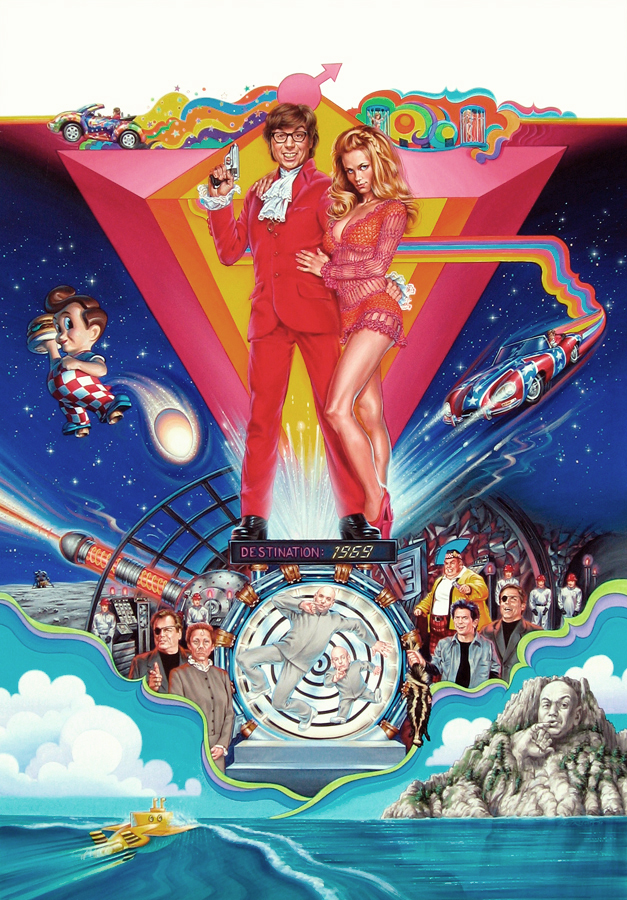

Roberts has had as much or more impact on popular and surf culture through his work as any artist in recent history. He also has fine art in museums, such as his “little red eggs,” valued at over $3 million. But what he does more prolifically than anyone else is the most fundamental of all surf art. Roberts paints waves.
Buck was a little intimated, but he’d learned a lesson when he first asked Van Hamersveld, who in addition to The Endless Summer movie poster did album cover art for the Beatles and Rolling Stones. After Van Hamersveld unexpectedly agreed to design an ESBC beer can, his wife, Alida Post, told Buck something that stuck with him.
“Do you want to know why John said yes?” she said. “It was because you asked.”
Buck called Roberts and asked. Roberts said yes.
“It’s amazing when you just ask somebody if they would like to do something,” Buck said. “It goes back to the big one, the first one for us, John van Hamersveld. You know, looking at him, and looking at us, there just seemed no way he’d have the time and energy to do something for us, but he said he would do it….It’s because these artists, while they might be wildly successful, it doesn’t mean they don’t want to do smaller projects like this.”
Roberts agreed because, like most artists, he just likes to make things. But there was another part of the project that really got his attention. This beer can was going to be animated by Augmented Reality.
Roberts has been making his living as an artist since he was 15. The AR component took him back to an animation project he did for a surfboard company when he was about 18, one that was done by making 200 sketches and shooting them with an 8 millimeter camera. In a career full of doing cool things, that little commercial had stuck with him. The notion of putting a living wave on a beer can was a new kind of challenge. Then he started talking with ESAW’s John McCullough, who has spearheaded a citywide AR project that has augmented public art around El Segundo, and “reality designer” Christian Enriquez, the technical wizard behind the whole ESAW AR project. Roberts got super stoked. He started making waves immediately.
“To be a part of this project with these guys, with John and Eli and Christian, that just totally triggered the whole animation thing inside of me,” Roberts said. “Then I did the painting digitally, so every element would be on its own layer. Christian would say, ‘We make the sand slowly move this way.’ And I’d be like ‘We make the backwash move that way. We make the underwater clouds move this way, then we roll the wave that way. We have the surfer jump in that way.’”
“It’s so fun,” Roberts said. “When you see the end result, it’s going to come to life.”
The Da Vinci of surf art
In the mid-70s, the beach boardwalks from Melbourne Beach to Cocoa Beach, Florida, were haunted by a skinny kid with a sketchbook. Phil Roberts had started drawing at five, and by his teenage years had an advanced caricature style he’d learned by studying Mad Magazine. This area, a barrier island off Palm Bay, was the epicenter of the East Coast surf scene, so Roberts also grew up surf-crazed.
“I started surfing in Jacksonville Beach one summer and was immediately hooked,” Roberts said. “Instead of paying attention in class, I’m drawing waves with a ballpoint pen on my blue jeans. That’s when I learned how to draw caricatures, from copying that magazine.”
The art that poured out of him was an unusual combination of Mad and Surfer. He drew surfers and waves and he was preternaturally skilled at it. He started making money as an artist at 13.
“The first thing I wanted to buy was a beautiful yellow Catri twin fin, used, for $150,” Roberts said. “I was 14 negotiating a payment schedule with Dick Catri. Two years later I was airbrushing boards for him — earning my money back. Tough business lessons for a young kid.”
At 15, Roberts got his first big break. He was airbrushing bikinis at a sidewalk art show when a surfer named Bob Carson approached him. Carson worked with Mike Tabeling, considered the first East Coast superstar-caliber surfer, who ran his own surfboard company. Carson took Roberts to the surfboard factory and he was hired on the spot to start painting surfboards.
Roberts was in the midst of a vibrant surf scene that centered around Shagg’s Surf Shop, owned by Catri (“the godfather of East Coast surfing”) and his wife Shagg, and populated by their three beautiful daughters and surfers such as Tabeling and his buddies and fellow surf legends Gary Propper and Bruce Valuzzi.
“I was airbrushing surfboards for all the factories back there in Cocoa Beach and Brevard County,” he said. “And my career was just laid out in front of me. All I had to do was follow the path. I’ve been enormously lucky in meeting all the right people at the right time, and that kind of led me from one thing to the next.”
All of these characters were first generation inductees into the East Coast Surfing Hall of Fame. Roberts would join them when he was inducted in 2016.
“Surfing is a family business,” he said at his induction ceremony. “I was raised in this industry from a really young age, and everything that I’ve ever done in my life and my career stemmed from and is based on surfing. It always comes back to surfing.”
By 17, Roberts’ career was thriving. He was working for several surfboard and apparel companies and his illustrations were appearing in magazines. But he aspired to more. So he enrolled at Pratt Institute in Brooklyn, which ranks among the top one percent of schools for visual arts and design and among the top five percent for architecture and fine art.
Roberts wanted to learn it all.
“I didn’t go in as an illustrator, because it was too limited and I was already published,” he recalled. “I was already selling illustrations for magazines. I was already in business … I wanted to be able to draw, paint, and sculpt a figure. I figured if I mastered that, I could do anything I wanted. I wasn’t wrong.”
“You’ve got to let an artist surprise you on what they can and can’t do,” Roberts said. “I subscribe to more of the European standards of requirements for an artist, where you’re expected to be able to do everything. It was kind of based off of Leonardo da Vinci. You are expected to draw, expected to do figures. You are expected to do architecture. Whereas in the United States, with capitalism, they want you to specialize in one thing.”
After college, Roberts was back in Florida doing his usual gigs, but also appearing more in magazines, both as an illustrator and occasionally a subject. Surfer Gary Propper had launched a magazine, called Easy Reader, in West Palm Beach, and profiled Roberts. Propper also connected Roberts with the owner of Sundek, the board-shorts maker who was then the biggest apparel maker in the surf industry.
The Sundek surf team included many of the best surfers in the world. One of Roberts early assignments was to illustrate the entire team surfing Sebastian Inlet, off Melbourne. It was a two page ad spread for Surfer Magazine, the most respected publication in the sport. When it appeared, editor Paul Holmes and publisher Steve Pezman called Roberts.
“They said, ‘Hey, we love what you did. Would you do that same thing for a cover for the Stubbies Surf Classic at Burleigh Heads Australia, and just put all the top professional surfers in it? But here’s the problem. You only have four weeks.”
“Of course, I didn’t say no,” Roberts said. “I was living in Florida at the time, and that was the toughest job because this was the end of October, and we got this winter swell. Six foot plus, perfect, glassy offshore wind waves were pumping down to the beach, and I had to stay in and paint.”
The issue came out in December 1982. His art included not only the cover but four inside pages.
“It was a big deal back east,” Roberts said. “I think I’m the first East Coast artist to ever get a cover. And I think there’s fewer than 12 illustrated covers in the history of Surfer Magazine, so just to be included with John Severson, Rick Griffin, and Bob Penuelas and the crew — it was an honor.”
Across the country, on the corner of Hollywood and Vine, a movie executive on a lunch break saw the cover at a newsstand. She thought the style would be perfect for movie posters. She tracked down Roberts in Florida.
“We are doing a movie,” she told him by phone. “It’s a ski movie. Do you think you could take a shot at it?”
It was called “Hotdog: The Movie” — “Kind of like Jackass for skiing,” Roberts said. It would become a cult classic. Roberts sent her the sketch she’d asked for, and just for good measure, included 20 other sketches to give her more options. She called back.
“We want to hire you,” she said. “By the way, you beat out Mort Drucker and Jack Davis from Mad Magazine for the job.”
“I just beat out my heroes, whom I learned how to draw cartoons from,” Roberts recalled. “I am just through the moon. So that Surfer Magazine cover launched me in Hollywood.”
He would work for Hollywood for the next two decades, drawing hundreds of the most iconic movie posters of the ‘80s and ‘90s and into the early aughts. His surfer buddy Gary Propper also made the move to California, where he would manage the comedian Gallagher and produce the Teenage Mutant Turtles movies. Roberts said the movie work complemented his surfing life perfectly.
“I never stopped doing surfing,” he said. “Surfing has always been my home base. Working in Hollywood is seasonal — summer box office during the spring, then a break, then at the end of the summer you work on Oscars-serious films for the wintertime. Then there’s a break after Halloween. So the between times I filled up with doing surfing.”
Roberts means not only surfing, but lending his talents to the surf world. He has drawn every major surfer over the last 40 years, and made sculptures of many of them. Among the most prestigious honors within the surf world is the Pipe Master Trophy, a bronze casting of original pipe master Gerry Lopez. Roberts has sculpted the trophies since 1996, and, in collaboration with Lopez, since 2008, has created trophy surfboards to accompany the honor. Surfer Kelly Slater has called those boards the most significant award in all of surfing.
“Every year Phil Roberts makes an amazing trophy … Gerry shapes it, they put a Jeff Divine photo on and Phil Roberts paints it up,” Slater told The Surfboard Project. “I mean, that thing is, in my assessment, the prized possession in surfing — not just to win that contest, but to have that piece of art. It’s really like a piece of surf history.”
Roberts marvels that the history of surfing is really not a long one, and through his art he’s gotten to know and often work with most of its major players. He worked closely with Lopez, was family friends with the Slaters (Kelly Slater’s mom, Judy, was a single mom and force of nature in Cocoa Beach. She was one of Robert’s earliest admirers and supporters). Today he works with the Duke Kahanamoku family to create art that preserves the surfing pioneer’s legacy (The International Museum of Surfing recently ran an exhibition of Roberts portraits of Duke). In the South Bay, Roberts is best known for the Dewey Weber statue in Hermosa. The statue was based on an iconic photo by Leroy Grannis, and Roberts worked closely with Grannis over the last month’s of the photographer’s life in 2011 to complete the work. His dedication to the project was indicative of the role he has played in the last half century of surf history — not just as an artist, but as a grateful surfer devoted to honoring the history of the sport that gave him his life.
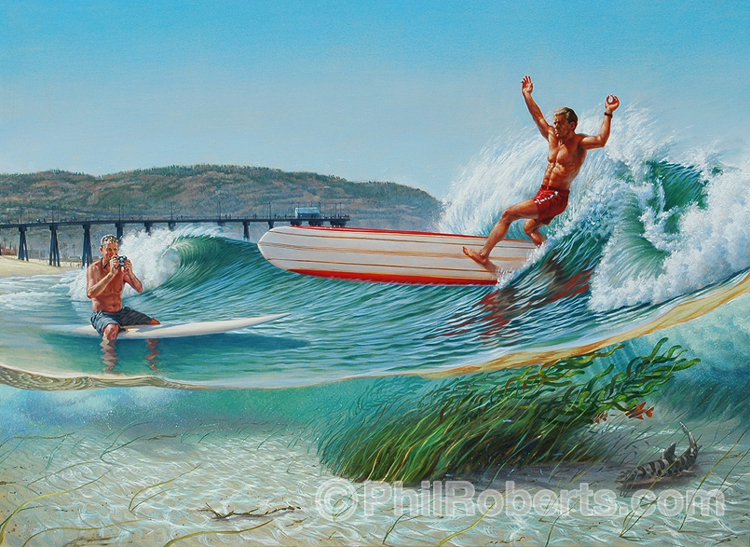
“I would visit Leroy when he was down in Carlsbad, and I showed him the painting I was doing while it was in progress,” Roberts said. “I would ask him, ‘What were you wearing? What camera were you using? What was the day like?’ And then, when it was close to finished, Leroy signed off on it and approved it.”
“I got to talk to Leroy on the phone just three hours before he passed away. I just thanked him. And I guaranteed him that his photograph would be turned into bronze, and then he would always be remembered.”
Temple of the wave
The throughline that runs through the bronze statues and trophies Roberts has created and his willingness to paint a beer can represents a reverence for waves and waveriders and his gratitude for the wild ride his life in surfing and art has been and continues to be.
“Art and surfing are married,” he told The Inertia a few years ago. “Surfboard shapers are sculptors. Every surfer is an artist.”
“The wave is its own entity. The wave will change and evolve as you are surfing. Not only do you make your own mark, but you also have to step aside from yourself and allow the wave to be the wave. When the two of you are dancing together, you respect the wave, but you still have your personality, it turns into a really beautiful thing.”
Surfing and art, in other words, are a spiritual practice for Roberts. He paraphrases a quote from Ram Dass, the Harvard psychologist-turned-guru, who talked about surfing as a means of finding union with the present moment.
“He said surfers have it really dialed in, because they are always present at the moment, in the curl of the wave, reacting and dealing with what is given to them right then — they are not looking too far down the line, and everything that is in the past crashes and blows away behind them,” Roberts said.
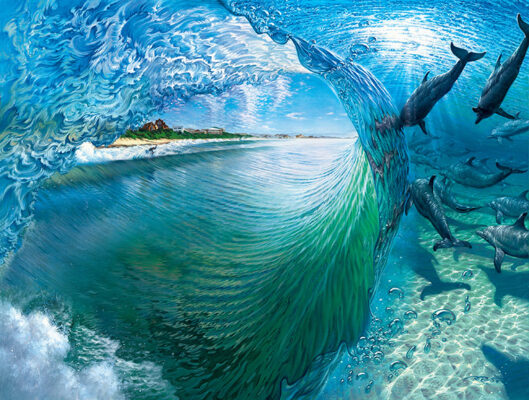
Be it everlasting bronze or a beer can that will be gone in a moment, it’s all about the temple of the wave. So of course Roberts said yes to the El Segundo Brewing Company. And then, when he began melding minds with Enriquez, the AR designer, he found himself right back in art school.
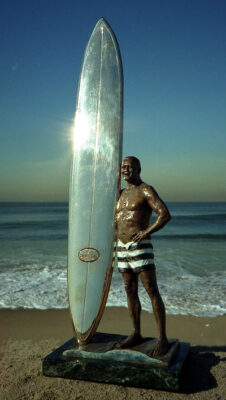
“I took an animation course my second year and did an animated surfing commercial for the surfboard factory I was working for back home. It was all ballpoint pen on paper and an eight millimeter camera,” he said. “You shoot two frames per second, and you just keep moving the boards of the illustrations off the pin board. I had 200 drawings of every little subtle movement.”
This project allowed Roberts to enter the world of Augmented Reality, in which animations are created digitally, and the potential for subtle movements are exponentially increased. Enriquez is one of the field’s emerging wizards, having previously worked to infuse the work of Hollywood production designer Rick Carter (Back to the Future, The Polar Express, Star Wars) with AR for a show at ESMoA. Enriquez is now working with ESAW to apply AR to public art and make El Segundo “the AR city.” The project is also a collaboration with Snapchat, whose parent company, SNAP, is a leader in the field, and whose AR Academy Enriquez attended.
But even Enriquez was astounded at the work that Roberts began pumping out and sending to him from his home in Newport Beach.
“Phil Roberts is a genius,” Enriquez said. “Our imaginations completely collided with one another. It was the most amazing process, getting inside his head and seeing the process.”
Buck said that as an art director he’s leery of giving an artist of Roberts’ magnitude much by way of guidance, but a short conversation between the two quickly settled upon the image.
“I just told him, how about a surfer jumping off the jetty into one of those giant waves at Hammerland?” Buck said. “And it was funny. He goes, ‘You know, I’ve been up there, and it’s not that sexy of a spot.’ And I was like, ‘Hey, we are a blue collar town, and that’s one of the most legendary surf spots in Southern California. We’ve got to be true to ourselves.’ And he said, ‘Alright, I got it.’ And he gave us this great, vibrant art that is just perfect. It’s exactly what we wanted.”
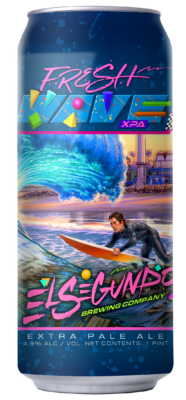
The beer itself is an EPA, or extra pale ale, which is only a 4.9 ABV (alcohol content) because it’s intended for people on the long walk that is the Art Walk.
“You don’t want to get hammered at your hometown event,” said McCullough, the ESAW event producer. “You don’t want a 7.8 beer that hits you in the face and be like, ‘Oh man, I’ve got to go find my kids.”
The whole thing is like a wave — the right artist, brewery, wizard, and event all coming together at just the right time and place for a fizzy little ride.
“ESBC coming out with an El Segundo Art Walk new release during the art walk, I mean, it’s just right on point,” McCullough said. “People in town are going to love it, and it’s just a great addition. It just makes a whole lot of sense.”
As for Roberts, he’s looking at that wave on the can and how it’s moving. He knows exactly where to catch it.
“I want to appeal to the inner surf child in all of us,” he said. “Like, ‘Dude, I could totally slot myself in, right there.”
The El Segundo Art Walk takes place August 27 from 3 to 9 p.m See elsegundoartwalk.com. Scan the QR Code at the top of this article to see the ESBC wave. Click on “The AR Experience” when the scan takes you to ElSegundoBrewing.com.


